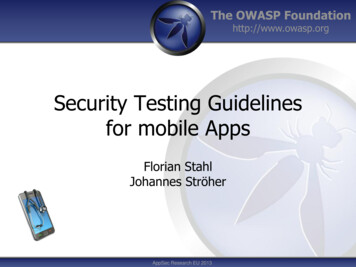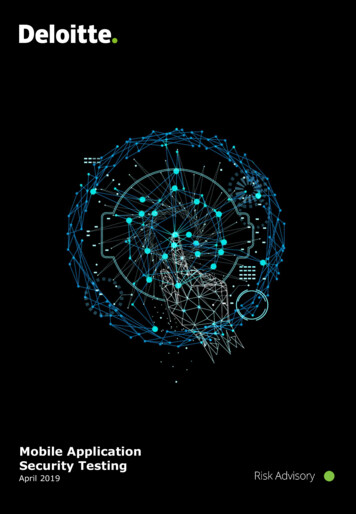
Transcription
The OWASP Foundationhttp://www.owasp.orgSecurity Testing Guidelinesfor mobile AppsFlorian StahlJohannes StröherAppSec Research EU 2013
Who we areFlorian StahlJohannes Ströher Lead Consultant for InformationSecurity, CISSP, CIPP/IT Consultant for InformationSecurity Security & Privacy advocate Expert for Mobile App Testing Works in Munich for msgsystems ag, Germany’s 5thlargest IT consulting and systemdevelopment company Developed the Mobile SecurityTesting Guide in his Master’sThesis Johannes.Stroeher@msg.de Florian.Stahl@msg-systems.comAppSec Research EU 20132
Agenda1. Motivation for Mobile Security Testing Guidelines Current mobile threat landscape and current situation Challenges2. Mobile Security Testing Guide (MSTG) Overview Intelligence Gathering, Threat Modeling & Vulnerability Analysis in specific Tools and examples3. SummaryAppSec Research EU 20133
Mobile App Threat Landscape Location-independent (mobile) “Always online” and traceable Consumerization – devices are built for personal use Focus on functionality and design rather than security Raise of sensitive use cases for mobile apps 163% increase of mobile malware in 2012 * “Hidden” business cases for free apps* Source: NQ Mobile Security ReportAppSec Research EU 20134
Situation Mobile Security Testing Mobile apps have some specific characteristicsregarding penetration testing Custom guidelines have not been available msg systems decided to develop guidelines (MSTG)with Munich University of Applied Sciences Similar guidelines published by OWASP:OWASP Mobile Security TestingAppSec Research EU 20135
Challenges Identify differences to common penetration tests Flexible Preconditions App Security also depends on device security (jailbreak, differentplatforms, versions, interfaces, MDM, etc.) Different attackers (internal, external, network or device access,blackbox / whitebox, etc.) Keep it flexible AND give specific hints to thepenetration tester Result: General process (mandatory) and supportingtools and practices (optional)AppSec Research EU 20136
Mobile Security Testing GuideOverviewStartPreparationIntelligence GatheringThreat ModelingVulnerability asuresShow AppSec Research EU 20137
Annotation forapp specific sub-processes The specific sub-processes were elaborated in detailfor Android and iOS An iOS native CRM app is used for illustrationbecause The CRM app supports many testable functions (authentication, ) It is open source more possibilities to demonstrate staticmethods It is a native app provides more attack surface for the tester We can install the relating CRM service on an own server noneed for taking care of impacts during the tests The CRM App was tested on an iPhone 4 with iOS 6AppSec Research EU 20138
Intelligence Gathering Try to catch as much as possible information aboutthe appIntelligenceGathering Consists of 2 analysisEnvironmentalAnalysisArchitecturalAnalysis Differences to conventional process Focus mainly on the architectural/technical part Not considering mobile specific requirementsAppSec Research EU 20139
Intelligence Gathering Environmental Analysis Focus on the company behind the app and their business case andthe relating stakeholders Analyze internal processes and structures Architectural Analysis App (network interfaces, used data, communication with otherressources, session management, jailbreak/rooting detection, ) Runtime environment (MDM, jailbreak/rooting, os version) Backend services (application server, databases, firewall, )AppSec Research EU 201310
Intelligence Gathering - Example Examples for collected information from theArchitectural Analysis for the CRM app App User session remains until the user logs off manually No financial transactions are included Runs on a jailbroken device no jailbreak detection Provides operations on server side CRM data for creating, reading, updating,deleting contacts, cases, calls, Runtime environment analysis is not relevant, because the app isrunning on a device from the tester Backend services Details about the version of the running CRM serviceAppSec Research EU 201311
Threat Modeling Identifying threats for the app - specific orprepared threats (e. g. OWASP Top 10) Should be done already in the development Risk rating e. g. with OWASP Risk Rating Developing countermeasures e. g. withbest practices or developers guides Differences to conventional process Most software testing processes do not include ThreatModeling Threat Modeling makes the complete process moretraceable and efficient for all participantsAppSec Research EU 2013StartDividing and clusteringappIdentifying threats foreach componentComparing all identifiedthreatsRating all risksDevelopingcountermeasures foridentified risksDefining test casesEnd12
Threat Modeling - Example Threat Modeling process example for the CRM App Information from the Intelligence Gathering App provides operations on CRM data on server side Specific threat Unauthorized reading of CRM data on the network traffic whilecommunicating with the CRM backendRelating countermeasure Implementing a secure transport layer protection (e. g. SSL, TLS) Relating test case Try to catch and read the network traffic between the CRM App and thebackendAppSec Research EU 201313
Vulnerability Analysis Identifying vulnerabilities in the app with theprevious created test cases Executing test cases with techniques from 3 odsDynamicmethodsForensicmethods Differences to conventional process Most software testing processes not include so many categories oftesting methodsAppSec Research EU 201314
Vulnerability Analysis Static methods Reverse Engineering Automatic and manual source code analysis Excursion: Tools for static methods Reverse Engineering Android: dex2jar, JD-GUI iOS: otool, class-dump-z Automatic and manual source codeanalysis Android: Androwarn, Andrubis,ApkAnalyser iOS: Flawfinder, Clang Static AnalyzerAppSec Research EU 201315
Vulnerability Analysis Dynamic methods Passive network monitoring and analyzing Network traffic analysis at different places in the network (at the device,gateway or in an own VPN) Active network capturing and manipulating (Wifi and cellular) Problems Native apps do not use always device proxy settings SSL encrypted connectionsSolutions Special apps that force the usage of device proxy settings or which breakSSL encrypted connections (mostly for jailbroken or rooted devices)AppSec Research EU 201316
Vulnerability Analysis Dynamic methods Runtime analysis Possible by analyzing the communicating process for internal components(Android: Intents; iOS: objc msgSend calls) Runtime manipulation Call or manipulate specific functions Read and write variable values File activity analysis Analysis file system changes during the runtimeAppSec Research EU 201317
Vulnerability Analysis Dynamic methods - CRM app example Network traffic analysis reveals usage of HTTP and sendingnon-encrypted sensitive user data (session id, username andpassword) Tools: Wireshark, BurpSuite, User authentication can be bypassed by runtime manipulation iOS tools: GNU debugger, Snoop-it, Cycript, Android tools: Mercury, Intent Sniffer, Intent Fuzzer, File activity analysis shows that user credentials (username andpassword) are stored in and used from the iOS keychain iOS tools: filemon.iOS, Snoop-it Android tools: androidAuditToolsAppSec Research EU 201318
Vulnerability Analysis Forensic methods Timeline analysis Analyze timestamps created from the file systemAnalysis of different file types SQLite databases Screenshots (iOS) Log files Keyboard cache (iOS) Cookies SharedPreferences (Android) Keychain (iOS)AppSec Research EU 201319
Vulnerability Analysis Forensic methods - CRM app example Timeline analysis shows that the app updates several files during itsruntime (*.plist file, database) Tools: mac-robber, mactime Analyzing identified files and standard file types reveal that the usercredentials are stored in plain text in the iOS keychain Tools: Keychain dumper, keychain viewer, AppSec Research EU 201320
SummaryMobile Security Testing Guide considers mobile characteristics, but is independentfrom technologies helps to improve transparency and repeatability formobile penetration testing is a holistic approach with sufficient flexibility and ultimately helps to improve mobile app securityAppSec Research EU 201321
The OWASP Foundationhttp://www.owasp.orgThank you for your attention!infosec@msg-systems.comFull thesis (in German) available on requestAppSec Research EU 2013
Mobile App Threat Landscape Location-independent (mobile) "Always online" and traceable Consumerization - devices are built for personal use Focus on functionality and design rather than security Raise of sensitive use cases for mobile apps 163% increase of mobile malware in 2012 * "Hidden" business cases for free apps











